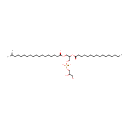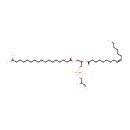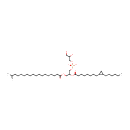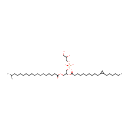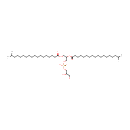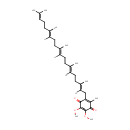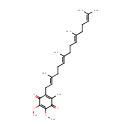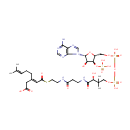
Search Results for compounds
Searching compounds for
returned 4373 results.
Displaying compounds 2281 - 2290 of
4373 in total
PG(19:iso/16:0) (PAMDB004111)
IUPAC:
(2,3-dihydroxypropoxy)[2-(hexadecanoyloxy)-3-[(17-methyloctadecanoyl)oxy]propoxy]phosphinic acid
CAS: Not Available
Description: PG(19:iso/16:0) is a phosphatidylglycerol. Phosphatidylglycerols consist of a glycerol 3-phosphate backbone esterified to either saturated or unsaturated fatty acids on carbons 1 and 2. As is the case with diacylglycerols, phosphatidylglycerols can have many different combinations of fatty acids of varying lengths and saturation attached to the C-1 and C-2 positions. PG(19:iso/16:0), in particular, consists of one 17-methylocatdecanoyl chain to the C-1 atom, and one hexadecanoyl to the C-2 atom. In Pseudomonas aeruginosa glycerophospholipid metabolism, phosphatidylglycerol is formed from phosphatidic acid (1,2-diacyl-sn-glycerol 3-phosphate) by a sequence of enzymatic reactions that proceeds via two intermediates, cytidine diphosphate diacylglycerol (CDP-diacylglycerol) and phosphatidylglycerophosphate (PGP, a phosphorylated phosphatidylglycerol). Phosphatidylglycerols, along with CDP-diacylglycerol, also serve as precursor molecules for the synthesis of cardiolipin, a phospholipid found in membranes.
PG(19:iso/16:1(9Z)) (PAMDB004112)
IUPAC:
(2,3-dihydroxypropoxy)({2-[(9Z)-hexadec-9-enoyloxy]-3-[(17-methyloctadecanoyl)oxy]propoxy})phosphinic acid
CAS: Not Available
Description: PG(19:iso/16:1(9Z)) is a phosphatidylglycerol. Phosphatidylglycerols consist of a glycerol 3-phosphate backbone esterified to either saturated or unsaturated fatty acids on carbons 1 and 2. As is the case with diacylglycerols, phosphatidylglycerols can have many different combinations of fatty acids of varying lengths and saturation attached to the C-1 and C-2 positions. PG(19:iso/16:1(9Z)), in particular, consists of one 17-methylocatdecanoyl chain to the C-1 atom, and one 9Z-hexadecenoyl to the C-2 atom. In Pseudomonas aeruginosa glycerophospholipid metabolism, phosphatidylglycerol is formed from phosphatidic acid (1,2-diacyl-sn-glycerol 3-phosphate) by a sequence of enzymatic reactions that proceeds via two intermediates, cytidine diphosphate diacylglycerol (CDP-diacylglycerol) and phosphatidylglycerophosphate (PGP, a phosphorylated phosphatidylglycerol). Phosphatidylglycerols, along with CDP-diacylglycerol, also serve as precursor molecules for the synthesis of cardiolipin, a phospholipid found in membranes.
PG(19:iso/17:0cycw7c) (PAMDB004113)
IUPAC:
(2,3-dihydroxypropoxy)(2-{[8-(2-hexylcyclopropyl)octanoyl]oxy}-3-[(17-methyloctadecanoyl)oxy]propoxy)phosphinic acid
CAS: Not Available
Description: PG(19:iso/17:0cycw7c) is a phosphatidylglycerol. Phosphatidylglycerols consist of a glycerol 3-phosphate backbone esterified to either saturated or unsaturated fatty acids on carbons 1 and 2. As is the case with diacylglycerols, phosphatidylglycerols can have many different combinations of fatty acids of varying lengths and saturation attached to the C-1 and C-2 positions. PG(19:iso/17:0cycw7c), in particular, consists of one 17-methylocatdecanoyl chain to the C-1 atom, and one heptadec-9-10-cyclo-anoyl to the C-2 atom. In Pseudomonas aeruginosa glycerophospholipid metabolism, phosphatidylglycerol is formed from phosphatidic acid (1,2-diacyl-sn-glycerol 3-phosphate) by a sequence of enzymatic reactions that proceeds via two intermediates, cytidine diphosphate diacylglycerol (CDP-diacylglycerol) and phosphatidylglycerophosphate (PGP, a phosphorylated phosphatidylglycerol). Phosphatidylglycerols, along with CDP-diacylglycerol, also serve as precursor molecules for the synthesis of cardiolipin, a phospholipid found in membranes.
PG(19:iso/18:1(9Z)) (PAMDB004114)
IUPAC:
(2,3-dihydroxypropoxy)({3-[(17-methyloctadecanoyl)oxy]-2-[(9Z)-octadec-9-enoyloxy]propoxy})phosphinic acid
CAS: Not Available
Description: PG(19:iso/18:1(9Z)) is a phosphatidylglycerol. Phosphatidylglycerols consist of a glycerol 3-phosphate backbone esterified to either saturated or unsaturated fatty acids on carbons 1 and 2. As is the case with diacylglycerols, phosphatidylglycerols can have many different combinations of fatty acids of varying lengths and saturation attached to the C-1 and C-2 positions. PG(19:iso/18:1(9Z)), in particular, consists of one 17-methylocatdecanoyl chain to the C-1 atom, and one 9Z-octadecenoyl to the C-2 atom. In Pseudomonas aeruginosa glycerophospholipid metabolism, phosphatidylglycerol is formed from phosphatidic acid (1,2-diacyl-sn-glycerol 3-phosphate) by a sequence of enzymatic reactions that proceeds via two intermediates, cytidine diphosphate diacylglycerol (CDP-diacylglycerol) and phosphatidylglycerophosphate (PGP, a phosphorylated phosphatidylglycerol). Phosphatidylglycerols, along with CDP-diacylglycerol, also serve as precursor molecules for the synthesis of cardiolipin, a phospholipid found in membranes.
PG(19:iso/19:0cycv8c) (PAMDB004115)
IUPAC:
(2,3-dihydroxypropoxy)(2-{[10-(2-hexylcyclopropyl)decanoyl]oxy}-3-[(17-methyloctadecanoyl)oxy]propoxy)phosphinic acid
CAS: Not Available
Description: PG(19:iso/19:0cycv8c) is a phosphatidylglycerol. Phosphatidylglycerols consist of a glycerol 3-phosphate backbone esterified to either saturated or unsaturated fatty acids on carbons 1 and 2. As is the case with diacylglycerols, phosphatidylglycerols can have many different combinations of fatty acids of varying lengths and saturation attached to the C-1 and C-2 positions. PG(19:iso/19:0cycv8c), in particular, consists of one 17-methylocatdecanoyl chain to the C-1 atom, and one heptadec-11-12-cyclo-anoyl to the C-2 atom. In Pseudomonas aeruginosa glycerophospholipid metabolism, phosphatidylglycerol is formed from phosphatidic acid (1,2-diacyl-sn-glycerol 3-phosphate) by a sequence of enzymatic reactions that proceeds via two intermediates, cytidine diphosphate diacylglycerol (CDP-diacylglycerol) and phosphatidylglycerophosphate (PGP, a phosphorylated phosphatidylglycerol). Phosphatidylglycerols, along with CDP-diacylglycerol, also serve as precursor molecules for the synthesis of cardiolipin, a phospholipid found in membranes.
PG(19:iso/19:iso) (PAMDB004116)
IUPAC:
{2,3-bis[(17-methyloctadecanoyl)oxy]propoxy}(2,3-dihydroxypropoxy)phosphinic acid
CAS: Not Available
Description: PG(19:iso/19:iso) is a phosphatidylglycerol. Phosphatidylglycerols consist of a glycerol 3-phosphate backbone esterified to either saturated or unsaturated fatty acids on carbons 1 and 2. As is the case with diacylglycerols, phosphatidylglycerols can have many different combinations of fatty acids of varying lengths and saturation attached to the C-1 and C-2 positions. PG(19:iso/19:iso), in particular, consists of two 17-methylocatdecanoyl chains at positions C-1 and C-2. In Pseudomonas aeruginosa glycerophospholipid metabolism, phosphatidylglycerol is formed from phosphatidic acid (1,2-diacyl-sn-glycerol 3-phosphate) by a sequence of enzymatic reactions that proceeds via two intermediates, cytidine diphosphate diacylglycerol (CDP-diacylglycerol) and phosphatidylglycerophosphate (PGP, a phosphorylated phosphatidylglycerol). Phosphatidylglycerols, along with CDP-diacylglycerol, also serve as precursor molecules for the synthesis of cardiolipin, a phospholipid found in membranes.
(S)-Succinyldihydrolipoamide (PAMDB004121)
IUPAC:
4-{[(3R)-7-carbamoyl-1-sulfanylheptan-3-yl]sulfanyl}-4-oxobutanoic acid
CAS: Not Available
Description: (S)-Succinyldihydrolipoamide is a metabolite (a product as well as a substrate) in glutamate degradation. It is also invovled in citrate cycle and is a reactant for oxoglutarate dehydrogenase (EC 1.2.4.2) and dihydrolipoyllysine-residue succinyltransferase (EC 2.3.1.61).
Ubiquinone-5 (PAMDB004124)
IUPAC:
2,3-dimethoxy-5-methyl-6-[(2E,6E,10E,14E)-3,7,11,15,19-pentamethylicosa-2,6,10,14,18-pentaen-1-yl]cyclohexa-2,5-diene-1,4-dione
CAS: Not Available
Description: Ubiquinone-5 is a member of the chemical class known as Polyprenylbenzoquinones. These are compounds containing a polyisoprene chain attached to a quinone at the second ring position. Ubiquione-5 has just 5 isoprene units. Normally in Pseudomonas aeruginosa the active form of Ubiquinone has 8 isoprene units (Ubiquinone-8) and in humans it normally has 10. Ubiquinone-5 is a ??ailed??or incomplete version of Ubiquinone 8 that arises from conjugation by a shortened prenyl tail via 4-hydroxybenzoate polyprenyltransferase. Ubiquionone is involved in cellular respiration. It is fat-soluble and is therefore mobile in cellular membranes; it plays a unique role in the electron transport chain (ETC). In the inner bacterial membrane, electrons from NADH and succinate pass through the ETC to the oxygen, which is then reduced to water. The transfer of electrons through ETC results in the pumping of H+ across the membrane creating a proton gradient across the membrane, which is used by ATP synthase (located on the membrane) to generate ATP.
Ubiquinone-4 (PAMDB004125)
IUPAC:
2,3-dimethoxy-5-methyl-6-[(2E,6E,10E)-3,7,11,15-tetramethylhexadeca-2,6,10,14-tetraen-1-yl]cyclohexa-2,5-diene-1,4-dione
CAS: Not Available
Description: Ubiquinone-4 is a member of the chemical class known as Polyprenylbenzoquinones. These are compounds containing a polyisoprene chain attached to a quinone at the second ring position. Ubiquione-4 has just 4 isoprene units. Normally in Pseudomonas aeruginosa the active form of Ubiquinone has 8 isoprene units (Ubiquinone-8) and in humans it normally has 10. Ubiquinone-4 is a ??ailed??or incomplete version of Ubiquinone 8 that arises from conjugation by a shortened prenyl tail via 4-hydroxybenzoate polyprenyltransferase. Ubiquionone is involved in cellular respiration. It is fat-soluble and is therefore mobile in cellular membranes; it plays a unique role in the electron transport chain (ETC). In the inner bacterial membrane, electrons from NADH and succinate pass through the ETC to the oxygen, which is then reduced to water. The transfer of electrons through ETC results in the pumping of H+ across the membrane creating a proton gradient across the membrane, which is used by ATP synthase (located on the membrane) to generate ATP.
Halide (PAMDB004133)
IUPAC:
(3E)-3-{2-[(2-{3-[(2R)-3-[({[({[(2R,3S,4R,5R)-5-(6-amino-9H-purin-9-yl)-4-hydroxy-3-(phosphonooxy)oxolan-2-yl]methoxy}(hydroxy)phosphoryl)oxy](hydroxy)phosphoryl}oxy)methyl]-2-hydroxy-3-methylbutanamido]propanamido}ethyl)sulfanyl]-2-oxoethylidene}-7-methyloct-6-enoic acid
CAS: Not Available
Description: Any heteroatomic molecular entity that is a chemical compound of halogen with other chemical elements
